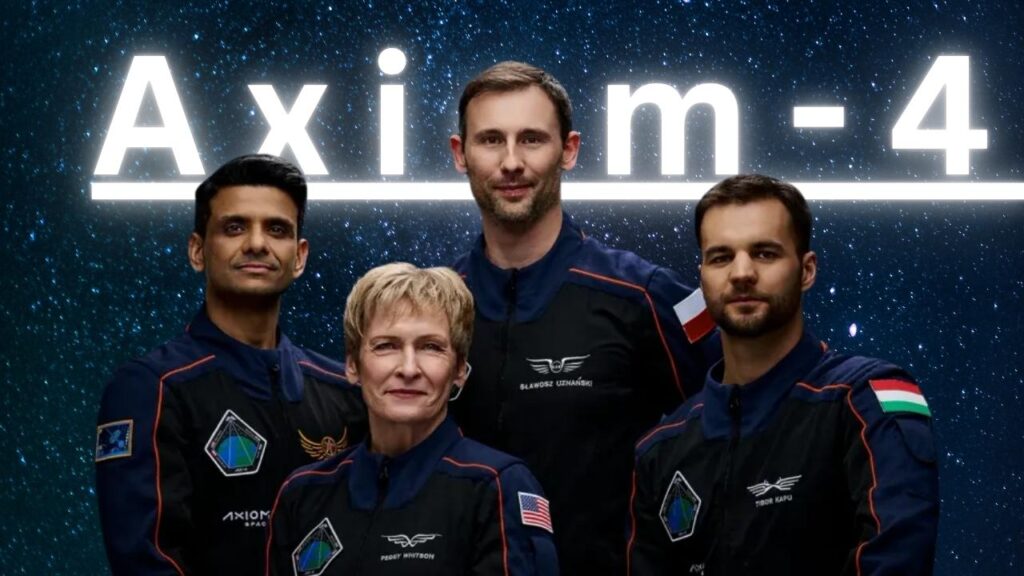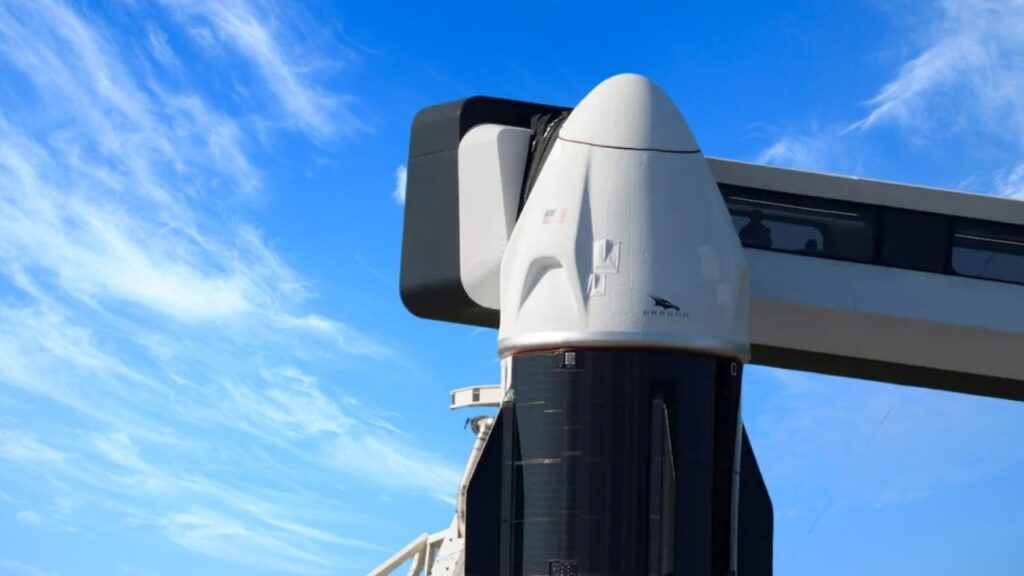Axiom‑04 Mission Postponed Again After Propulsion‑Bay Leak: The Axiom‑04 mission has been postponed once more—this time due to a liquid oxygen (LOx) leak in the propulsion bay of SpaceX’s Falcon 9 rocket. Both SpaceX and ISRO are now working hand-in-hand to fix the issue and schedule a new launch date.

Why This Delay Matters
Kids and grown-ups alike can appreciate this: the mission isn’t just “another space trip.” It’s a historic moment for India, especially since Group Captain Shubhanshu Shukla is set to become the first Indian astronaut to visit the ISS, and only the second Indian ever in space, after Rakesh Sharma in 1984.
Think about that—a dream rooted in years of training, teamwork, and astrophysics! It’s got the whole world watching, from young space fans to rocket scientists.
The Context: How We Got Here
| Milestone | Details |
|---|---|
| Mission | Axiom‑04 (Ax‑4) |
| Crew | Shubhanshu Shukla (India), Peggy Whitson (USA), Sławosz Uznański‑Wiśniewski (Poland), Tibor Kapu (Hungary) |
| Rocket & Launch Site | SpaceX Falcon 9 from NASA’s Kennedy Space Center (LC‑39A), Florida |
| Duration | 14 days on the ISS |
| Original Schedule | Planned for June 10, 2025; delayed to June 11 due to weather; now postponed indefinitely due to technical issues |
| Issue Detected | LOx leak found during a 7-second hot-fire test on June 10 |
| Current Status | Repair in progress; awaiting validation tests and range clearance before a new launch date is set |
| Official Sources | ISRO statement on X; SpaceX confirmation; NASA acknowledges delay in mission blog |
| ISRO Involvement | Invested ₹550 crore in the mission; Shukla is serving pilot for Ax-4 |
| Significance | Marks international cooperation (India, USA, Poland, Hungary) and the return of India to human spaceflight |
| Crew Training | Months of simulations—including docking and splashdown practices—completed by all four crew members |
| More Info | axiomspace.com, isro.gov.in |
The Axiom‑04 mission delay might feel like a tech hiccup—but it’s a reminder that safety and precision win space races. With ISRO and SpaceX teaming up, and Shukla set to break barriers, the countdown will resume in true trailblazing style.
Stick around for the reboot—this mission is too impactful not to launch, and when it does, we’ll all be watching history in the making.
What Happened: The Leak-Investigation Timeline
- Pre‑Launch Preparations Begin
Falcon 9’s first stage booster was rolling through routine “static fire” checks to ensure engines, plumbing, and seals were all good to go. - Hot‑Fire Test on June 10
They fired up the rocket’s engine on the pad for 7 seconds—not to launch, just to test. During that, a LOx leak was spotted in the propulsion bay—a big no-no. - Emergency Stand‑Down
SpaceX posted an update announcing that they were standing down from the scheduled launch to allow time for repairs and rescheduling. - ISRO Joins the Talks
ISRO Chairman V. Narayanan confirmed the leak and announced validation testing will occur before the mission is cleared. - Delay Declared
The mission, set for June 11 at 5:30 p.m. IST from Cape Canaveral, is now indefinitely delayed, pending the repairs.
Meet the Crew
- Peggy Whitson (USA): Former NASA astronaut, now commanding her second private mission to the ISS. She holds the U.S. record for total time in space.
- Group Captain Shubhanshu Shukla (India):
- Born October 10, 1985, in Lucknow, India.
- Indian Air Force test pilot with ~2,000 flight hours in diverse aircraft.
- Selected in 2019 under India’s Human Spaceflight Programme; trained in Russia (Gagarin Centre) and Bangalore.
- Will become the first Indian on the ISS and only the second Indian in space after Rakesh Sharma (1984).
- Sławosz Uznański‑Wiśniewski (Poland): The second Polish astronaut ever (first since 1978).
- Tibor Kapu (Hungary): The second Hungarian to travel in space (first since 1980).
The Mission Plan
Once Ax‑4 gets off the ground, here’s what the crew is scheduled to do aboard the ISS:
- Docking & Arrival: Conducted by Shukla. The Dragon capsule docks with the ISS—an opportunity for students to learn about orbital mechanics.

- Science Galore:
- Health Studies: How does the body behave in zero gravity? Tracking heart, muscles, and sleep cycles helps plan longer missions (like to Mars).
- Microalgae Nutrition: Led partly by Shukla. This explores how algae may keep astronauts fed in the future.
- AI in Space: Testing AI-assist tools for health and diagnostics—this is science mixed with tech for future crews.
- Materials Research: Studying metal crystallization in microgravity could lead to breakthroughs in manufacturing and 3D printing in space.
- Cultural Exchange: The mission itself represents global unity—an Indian pilot, American commander, plus Polish and Hungarian specialists working together.
Why It’s Big News
- For India
- Shukla will make history as the first Indian to reach the ISS and the second Indian in space after nearly 41 years.
- This mission signals a major leap for India in crewed spaceflight. ISRO’s Gaganyaan is closer thanks to this collaboration.
- For International Spaceflight
- Axiom Space is pioneering private astronaut missions, bridging NASA, SpaceX, and other global space agencies.
- Brings in a new wave of private-public partnerships—a strong trend in 21st-century space exploration.
- For Science & Research
- Over 60 experiments launched, covering aerospace tech, life sciences, AI, and more. These are real-world applications that help future missions deeper into space.
What Comes Next (Step‑by‑Step)
1. Leak Repair & Seal Replacement
SpaceX engineers are working on the LOx tank seals and propulsion-bay hardware. Re-tests ensure safety and performance.
2. Re‑Validation Testing
After the fix, a repeat hot-fire test is needed. This confirms the leak is fixed and the propulsion bay can handle liftoff conditions.
3. New Launch Date
Coordinating with NASA’s range operations, Axiom, SpaceX, and ISRO will pick a fresh launch window.
4. Final Countdown
That includes weather clearances, system go-no-go checks, crew boarding, and—finally—liftoff toward the ISS.
Facts & Figures You Can Trust
- Leak spotted during 7-second hot fire on June 10, 2025.
- Crew of four: India, USA, Poland, Hungary.
- First Indian ISS trip since Rakesh Sharma (1984).
- Mission investment: ISRO committed ~₹550 crore toward Shukla’s seat and mission support.
- Private mission model: Axiom and SpaceX pave the way for commercial space travel.
Trusted Sources
- ISRO official site and media channels
- SpaceX announcements
- NASA blog reporting mission delay
- EconomicTimes / LiveMint for detailed mission coverage.
AI Predicts Stronger Metal‑Doped Materials With Improved Mechanical Properties
Ultrasound Technique Accurately Detects Defects in Aluminum Manufacturing
New Bio-Based Hot Glue Made From Industrial Waste Outperforms Traditional Adhesives
FAQs About Axiom‑04 Mission Postponed Again After Propulsion‑Bay Leak
Q: Why is the mission delayed again?
A: A LOx leak was discovered in the Falcon 9 propulsion bay during a hot‑fire test, and engineers need to repair and re‑validate the system before proceeding.
Q: Is this dangerous?
A: Space travel always involves risk. Spotting the leak before launch shows that safety systems worked. Fixing it first is exactly the correct, responsible move.
Q: When will the mission launch?
A: That’s still TBD. SpaceX and ISRO will announce a new date once repairs, hot‑fire tests, and range scheduling are complete.
Q: Who is Shubhanshu Shukla?
A: A decorated Indian Air Force test pilot, and ISRO-trained astronaut. This mission will make him the first Indian on the ISS and the second Indian ever in space.
Q: What will the crew do there?
A: They’ll complete 60+ experiments across multiple fields: human health, microalgae, AI, materials, and space science.
Q: Why is this mission so historic?
A: It combines:
- A private-public partnership with global impact.
- The first-ever ISS mission involving India, Poland, and Hungary together.
- A milestone for India’s human spaceflight journey.
Key Takeaways & Advice
- Safety is non-negotiable.
Finding and fixing leaks now is way better than risking it at launch. It’s how NASA, ISRO, and SpaceX stay top-tier. - This mission sets the bar for global teamwork.
Four astronauts representing four countries prove space exploration is the ultimate team sport. - Stay tuned through official channels.
- Kids, here’s the lesson:
Always double-check, stay patient, and learn from setbacks. Even rockets can get hiccups! - Professionals, watch space commerce closely:
Ax‑4 is part of a big global trend—civilian space tourism, private astronaut missions, and multi-national crew cooperation.






